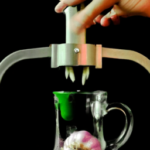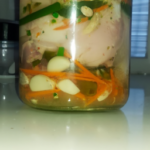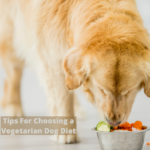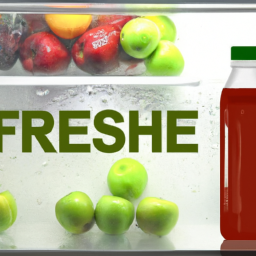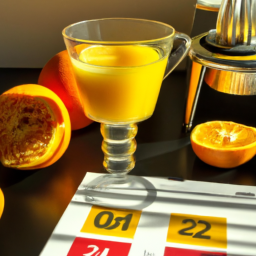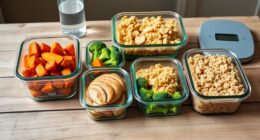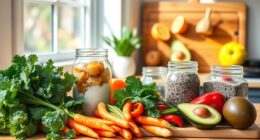As a backyard chicken owner, I am always looking for ways to ensure the well-being and happiness of my flock.
One natural supplement that I have found to be particularly effective is garlic juice. Garlic has been used for centuries as a natural antibiotic and immune system booster, and it can be a great addition to your chicken’s diet.
In this article, I will share with you how to make garlic juice for chickens and the benefits it can have for their health. I will also cover how to safely administer garlic juice to your chickens and some precautions to keep in mind.
By the end of this article, you will have all the information you need to start using garlic juice as a natural supplement for your flock.
Key Takeaways
- Garlic juice is a natural supplement that can keep chickens healthy and boost their immune system.
- To make garlic juice, fresh and high-quality garlic bulbs should be used and the juice should be diluted with clean water.
- Garlic juice can be administered by mixing it into drinking water or feed, but it should be given in moderation to avoid any side effects.
- Other herbal and natural remedies for chickens include oregano oil, apple cider vinegar, mint, thyme, and lavender, which can help improve their overall health without harsh chemicals or synthetic additives.
Benefits of Garlic Juice for Chickens
Garlic juice is an excellent addition to chicken feed as it’s known to provide numerous health benefits for our feathered friends. One of the most important benefits of garlic juice is its antibiotic properties. Garlic juice has been used for centuries as a natural remedy for infections, and it’s just as effective for chickens.
Adding garlic juice to their feed can help prevent and treat bacterial infections, which are common in chickens. Another benefit of garlic juice for chickens is that it boosts their immune system. Garlic contains compounds that stimulate the production of white blood cells, which are responsible for fighting off infections and diseases.
By adding garlic juice to their diet, we can help our chickens stay healthy and strong. This is especially important during the winter months when colds and flu are more prevalent.
Now, let’s move on to the next section and learn how to prepare garlic for juice.
Preparing Garlic for Juice
You probably already have this ingredient in your kitchen, and it’s a key component in boosting your feathered friends’ health. Garlic preparation is essential for getting the most out of this potent ingredient. Here are a few things to keep in mind before you start juicing:
- First, make sure to choose fresh, high-quality garlic bulbs.
- The cloves should be firm, plump, and free of any soft spots or mold.
- Once you have your garlic bulbs, it’s time to start preparing them for juice.
- The first step is to peel the cloves and separate them from the bulb.
- Next, you can chop the cloves into smaller pieces to make it easier to extract the juice.
- If you don’t plan on using the garlic right away, it’s important to store it properly to maintain its freshness.
- Keep the cloves in an airtight container in a cool, dark place, and avoid exposing them to moisture or direct sunlight.
With your garlic prepared and ready to go, it’s time to move on to the next step: extracting the juice.
(Note: The subsequent section will cover methods for extracting garlic juice.)
Methods for Extracting Garlic Juice
Now that we’ve got our garlic cloves ready, we need to extract the juice. There are three effective methods: using a garlic press, blending the garlic, and using a juicer. Each method has its own benefits and drawbacks, so it’s important to choose the one that works best for you.
Let’s take a closer look at each method so we can decide which one to use.
Using a Garlic Press
By using a garlic press, it’s easier to extract the juices from the garlic cloves, making it a more efficient way to add flavor and boost immunity in your chickens.
While there are garlic press alternatives such as using a mortar and pestle or a grater, a garlic press is the quickest and most convenient method. It also ensures that the maximum amount of juice is extracted from the garlic without any wastage.
Using fresh garlic has many benefits, including higher nutrient content and stronger flavor, which can have a positive impact on your chicken’s overall health and immunity.
To use a garlic press, simply peel the garlic cloves and place them in the press. Squeeze the handles together to crush the garlic and extract the juice. Repeat until you have enough juice for your intended use.
Another benefit of using a garlic press is that it creates a finer texture of garlic juice, which can be easier to blend into your chicken’s feed or water. Speaking of blending garlic, the next step in making garlic juice for chickens is to blend the extracted juice with water or other ingredients to create a solution that can be easily added to your chicken’s diet.
Blending Garlic
After crushing the garlic cloves with a press, it’s time to move on to the next step of creating garlic juice for chickens: blending garlic. Blending is necessary to make sure that the garlic’s active ingredients are fully extracted, making the juice more potent and effective.
To start blending garlic, you’ll need a blender or food processor. Simply add the crushed garlic to the blender with water or other ingredients according to your chosen garlic juice recipe. Blend the mixture until the garlic is completely liquefied and the mixture is smooth.
Strain the mixture through cheesecloth or a fine mesh strainer to remove any remaining chunks or fibers. And voila, you now have a potent garlic juice that can be used to boost your chickens’ immune systems and keep them healthy!
Now that you’ve blended the garlic, the next step is to use a juicer to extract even more juice from the garlic. This step will help ensure that you’re getting the maximum amount of juice from your garlic and that you’re not wasting any of its valuable nutrients.
Using a Juicer
Using a juicer can greatly enhance the potency of your garlic mixture for chickens. When blending garlic, it can be difficult to achieve a consistent texture and extract all of the beneficial compounds from the cloves. However, with a juicer, you can extract the garlic juice with ease and achieve a uniform consistency that will make it easier to mix with other supplements and feed.
To use a juicer, simply peel and chop your garlic cloves into small pieces and feed them into the machine. Be sure to follow the manufacturer’s instructions for juicer maintenance, as the garlic can leave a strong odor and residue in the machine.
Once you have extracted the juice, you can mix it with water or other supplements to dilute the potency before adding it to your chickens’ feed. By diluting the garlic juice, you can ensure that your chickens receive the proper dosage without overwhelming their systems.
In the next section, we’ll discuss the importance of diluting garlic juice and how to do it effectively.
Diluting Garlic Juice
Let’s dilute the garlic juice to make it safe and effective for our feathered friends. Garlic juice dilution is necessary to avoid harming the chickens with its strong potency. The best dilution ratio is 1:10, which means 1 part garlic juice and 10 parts water. This ratio ensures that the garlic juice is not too strong to irritate the chickens’ digestive system.
To make the diluted garlic juice, mix 1 part garlic juice with 10 parts water in a container. It is essential to use clean water to avoid any contamination that may affect the chickens’ health. The table below shows the measurement of garlic juice and water in milliliters for different volumes of diluted garlic juice.
| Volume of Diluted Garlic Juice | Garlic Juice (ml) | Water (ml) |
|---|---|---|
| 1 liter | 100 | 900 |
| 500 ml | 50 | 450 |
| 250 ml | 25 | 225 |
With the diluted garlic juice ready, we can now proceed to administer it to our chickens to boost their immunity and protect them from harmful pathogens.
Administering Garlic Juice to Chickens
Now that we’ve diluted the garlic juice, we can move on to administering it to our chickens. Garlic has many benefits for overall chicken health, such as boosting the immune system, preventing parasites, and improving digestion. However, note that garlic should be given in moderation, as overconsumption can lead to potential side effects, such as anemia and respiratory issues.
To administer the garlic juice, we can mix it into the chickens’ drinking water or add it to their feed. It’s recommended to start with a small amount, such as one teaspoon per gallon of drinking water, and gradually increase the amount if necessary. It’s also important to monitor the chickens for any adverse reactions and to discontinue use if any issues arise.
Moving forward, the frequency of garlic juice treatment will depend on the individual needs of your flock. Consult with a veterinarian or poultry expert to determine the appropriate dosage and frequency for your specific situation. With proper administration and monitoring, garlic juice can be a great addition to your chickens’ diet and overall health.
Frequency of Garlic Juice Treatment
The frequency of administering garlic juice to your flock can greatly impact its benefits. As with any natural remedy, it’s important to start small and gradually increase as needed.
The recommended frequency of garlic juice treatment is once per week for healthy chickens, but it can be increased to twice a week during times of stress or illness. Dosage is also an important factor to consider when administering garlic juice.
A general rule of thumb is to mix one clove of garlic per quart of water. However, it’s important to note that the dosage may vary depending on the size and health of your flock. When compared to other natural remedies, garlic juice is a more effective and safer option.
It not only boosts the immune system of your chickens but also aids in digestion and repels parasites. It’s important to always be mindful of potential side effects and consult with a professional before administering any natural remedy to your flock.
Precautions and safety measures should be taken seriously to ensure the health and well-being of your chickens.
Precautions and Safety Measures
Ensuring the safety of your flock is crucial when administering natural remedies, so it’s important to take precautions and consult with a professional. Here are some precautions to take when handling garlic juice for chickens:
-
Wear gloves and protective clothing when handling garlic juice to prevent contact with your skin.
-
Use a clean and sanitized container to store the garlic juice, and make sure to label it properly.
-
Store the garlic juice in a cool, dark place to maximize its shelf life.
-
Consult with a veterinarian or poultry expert before administering garlic juice to your flock, especially if they have any underlying health issues.
When it comes to alternative garlic supplements for chickens, there are other options available besides garlic juice. These include garlic powder and garlic granules, which can be added to your chickens’ feed or water.
Alternative Garlic Supplements
To provide alternative options for garlic supplements, garlic powder and granules can be easily added to your flock’s feed or water. Garlic powder is made by grinding dried garlic cloves into a fine powder, while garlic granules are made by dehydrating garlic cloves and then breaking them into small pieces. Both garlic powder and granules are readily available at most pet stores or online.
While garlic juice is a popular herbal remedy for chickens, using garlic powder or granules can be a convenient and effective way to provide your flock with the benefits of garlic without the hassle of making garlic juice. Garlic is known for its natural antibiotic properties, which can help boost your chickens’ immune system and prevent common infections. However, it’s important to remember that garlic shouldn’t be used as a substitute for proper veterinary care.
Moving forward to the subsequent section about other natural supplements for chickens, it’s important to consider the many different herbal and natural remedies that can benefit your flock. From oregano oil to apple cider vinegar, there are many different supplements that can help keep your chickens healthy and happy. By incorporating a variety of natural supplements into your flock’s diet, you can help ensure that they stay healthy and strong for years to come.
Other Natural Supplements for Chickens
If you’re looking to boost your flock’s health naturally, there are plenty of other supplements available besides garlic. Some of the most effective natural remedies for chickens include herbal supplements. These supplements can help improve the overall health and well-being of your chickens, without the need for harsh chemicals or synthetic additives.
One popular herbal supplement for chickens is oregano oil. Oregano oil has natural antibacterial properties that can help prevent infections and boost the immune system. Another great option is apple cider vinegar. Adding a small amount of apple cider vinegar to your chickens’ water can help improve digestion, prevent intestinal parasites, and boost their overall health. Finally, consider incorporating herbs like mint, thyme, and lavender into your chickens’ diet. These herbs have natural antiviral and antibacterial properties, and can help keep your chickens healthy and happy.
| Herbal Supplement | Benefits | How to Use |
|---|---|---|
| Oregano Oil | Natural antibacterial properties, boosts immune system | Add a few drops to chickens’ water or feed |
| Apple Cider Vinegar | Improves digestion, prevents intestinal parasites, boosts overall health | Add a small amount to chickens’ water |
| Mint, Thyme, Lavender | Natural antiviral and antibacterial properties, promotes health and happiness | Add to chickens’ feed or coop bedding |
By incorporating these natural supplements into your chickens’ diet, you can help them stay healthy and happy without relying on harsh chemicals or synthetic additives. With a little bit of research and experimentation, you can find the perfect herbal supplements to support your flock’s health and well-being.
Frequently Asked Questions
Can garlic juice be used for other animals besides chickens?
Garlic juice benefits can be used for other animals besides chickens. It is one of the alternative natural remedies that can help fight off infections and boost the immune system. Its antibacterial and antiviral properties make it a great addition to any animal’s diet.
What is the shelf life of homemade garlic juice for chickens?
The shelf life of homemade garlic juice varies depending on the preservation methods used. When stored in a cool, dry place, it can last up to six months. It can also be used for other animals besides chickens, such as cows and horses.
Can garlic juice be used as a preventative measure for chicken illnesses?
Garlic juice benefits chickens by boosting their immune system, preventing infections and parasites. The recommended garlic juice dosage is 1-2 cloves per day, per chicken. It is a practical and effective preventative measure for chicken illnesses.
Is it safe to give garlic juice to chickens who are already on medication?
Giving garlic juice to chickens who are already on medication can have varying effects on their health. While it may enhance the effectiveness of the medication, it can also have potential side effects on chickens with certain medical conditions.
Can garlic juice be used in conjunction with other natural supplements for chickens?
Garlic juice benefits chickens by boosting their immune system and preventing parasites. It can be mixed with other natural supplements, but consult with a veterinarian before combining with medication.
Conclusion
In conclusion, if you want your chickens to be the healthiest and happiest they can be, you simply must try giving them garlic juice. The benefits are just too enormous to ignore.
Your chickens will be stronger, livelier, and more productive than ever before. They’ll lay more eggs, resist disease more easily, and even have a more pleasant odor. Plus, their meat will be more tender, flavorful, and nutritious. It’s like giving your chickens a superpower!
So why wait? Start preparing garlic juice for your chickens today. It’s easy, affordable, and incredibly effective. Your chickens will thank you for it every day, and you’ll love the peace of mind knowing that you’re doing everything you can to keep them healthy and happy.
And who knows? Maybe someday soon, you’ll even be able to taste the difference in your own cooking!
Ilana has been a vegan for over 10 years. She originally made the switch for health reasons, but soon found herself becoming more and more passionate about the ethical and environmental implications of a vegan lifestyle. Ilana is the author of The Graceful Kitchen, a blog all about veganism. She loves to cook up delicious and nutritious vegan meals, and share her recipes with others who are interested in leading a cruelty-free life. Ilana is also a strong advocate for using whole foods as the foundation of a healthy diet, and believes that going vegan is one of the best ways to achieve this.



